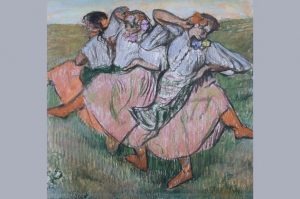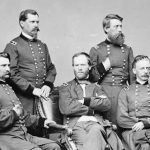 Animals
Animals  Animals
Animals  Weird Stuff
Weird Stuff 10 Weird Things People Used to Do at New Year’s
 Our World
Our World 10 Archaeological Discoveries of 2025 That Refined History
 Weird Stuff
Weird Stuff 10 Fascinating Facts You Might Not Know About Snow
 Miscellaneous
Miscellaneous Top 10 Things Crypto Was Supposed to Change & What Actually Did
 History
History 10 Huge Historical Events That Happened on Christmas Eve
 Music
Music 10 Surprising Origin Stories of Your Favorite Holiday Songs
 History
History 10 Less Than Jolly Events That Occurred on December 25
 Weird Stuff
Weird Stuff 10 Funny Ways That Researchers Overthink Christmas
 Politics
Politics 10 Political Scandals That Sent Crowds Into the Streets
 Animals
Animals 10 Species That Refused to Go Extinct
 Weird Stuff
Weird Stuff 10 Weird Things People Used to Do at New Year’s
 Our World
Our World 10 Archaeological Discoveries of 2025 That Refined History
Who's Behind Listverse?

Jamie Frater
Head Editor
Jamie founded Listverse due to an insatiable desire to share fascinating, obscure, and bizarre facts. He has been a guest speaker on numerous national radio and television stations and is a five time published author.
More About Us Weird Stuff
Weird Stuff 10 Fascinating Facts You Might Not Know About Snow
 Miscellaneous
Miscellaneous Top 10 Things Crypto Was Supposed to Change & What Actually Did
 History
History 10 Huge Historical Events That Happened on Christmas Eve
 Music
Music 10 Surprising Origin Stories of Your Favorite Holiday Songs
 History
History 10 Less Than Jolly Events That Occurred on December 25
 Weird Stuff
Weird Stuff 10 Funny Ways That Researchers Overthink Christmas
 Politics
Politics 10 Political Scandals That Sent Crowds Into the Streets
10 Things That Were Weirdly Renamed Because of a War
Modern warfare features many more weapons and tactics than only those seen on the battlefield. Propaganda is often used by all sides to maintain morale, turn public sentiment against the enemy, and quell dissent. In addition to usual propaganda tools like posters and broadcasts, references to enemy states are often erased from society.
This can happen automatically when businesses and people realize that sentiment has shifted, or it can be legislated by politicians. Examples of both can be found in almost every war of the 20th and 21st centuries. This has led to some interesting renamings of all kinds of things, some of which have stuck and are still used today, while others reverted back to their old names. Here are ten of the weirdest wartime renamings.
Related: 10 Weird Place Names And The Stories Behind Them
10 French Fries and French Toast
In 2003, U.S. lawmakers could no longer order French fries in three Washington cafeterias. Instead, they had to order a side of “freedom fries” with their meals or “freedom toast” instead of French toast with breakfast. Although some cafeteria staff called the change “completely ludicrous,” it was enacted by two lawmakers as a symbolic gesture to express their disapproval at France’s decision not to support the U.S. invasion of Iraq.
Private restaurants around the United States reportedly did the same, although the name did not stick, and U.S. relations with France eventually thawed. Other countries also opposed the invasion, including Germany and Russia, but France was accused of leading the opposition. And luckily for the others, they do not lend their names to many foods.[1]
9 Towns
Renaming towns was surprisingly common during the two world wars. Before them, there were a lot of Berlins in the world. One of these was in Colusa County, California. During the Second World War, the town received a telegram urging them to change their name. All towns called Berlin received the same request. However, the one in Colusa County never responded.
When journalists wanted to find out why, they discovered the name had already been changed 26 years earlier in response to anti-German sentiment during the First World War. Another town to change its name during World War I was Germantown. Historians reported the town was forced to change after a train carrying troops was stopped there. After spotting the signboard with the town’s name, soldiers became enraged and badly damaged the station.[2]
8 The Royal Surname
In a time long before modern public relations advisers could be consulted, Britain’s King George V made a shrewd call that not only preserved his place on the throne but also ensured a place for the royal family in Britain’s future. In 1917, after three brutal years of fighting against Germany, anti-German sentiment abounded in the UK. The problem was that the royals had German ancestry and relations.
The king’s cousin was the kaiser of Germany, and his wife was German. The dynasty to which the family belonged was Saxe-Coburg-Gotha which, often used in place of a surname, was a dead giveaway of their German roots. The king saw problems—and perhaps even a revolution—on the horizon if he did not act. So he created a family surname, choosing the more British-sounding “Windsor” for himself and his descendants.[3]
7 Dog Breeds
Another name that changed in 1917, although it officially reverted back in 1977, was that of the German shepherd dog. The dogs were widely used by both sides during the two world wars, but with Germany as the enemy, it did not sit right with some people that the dogs should be called German shepherds.
In response, the name was changed, although it took a few different forms. The American Kennel Club dropped “German” from the name in 1917, while the British went for an entire rebrand. They chose the name “Alsatian,” which alludes to a French town in an area taken over by Germany in an earlier war.[4]
6 Coffee
In the early 1900s, it was popular for Parisian cafes to emulate those in Vienna. Viennese coffee culture was viewed as luxurious and sophisticated. Many cafes in France served café viennois, a hot, sweet coffee-based beverage topped with whipped cream. When the First World War broke out in 1914, public opinion of Germany soured in France. Fighting alongside Germany in the war was the Austro-Hungarian Empire, of which Vienna was the capital.
The public despised all German-sounding names, so savvy cafe owners quickly renamed café viennois to café liégeois. The name is derived from the town of Liège in Belgium, the site of a famous battle where the Belgians unexpectedly delayed the German advance toward France by 12 days. The resistance cost the Germans considerable resources, including 5,000 men, and gave France more time to prepare its defenses.[5]
5 Spanish Flu
This deadly pandemic did not exactly have its name changed by war. The First World War did shape the name it was given, but we do not know what it might have been called were it not for the wartime circumstances. The Spanish flu was unlikely to have originated in Spain, but Spain was where most of the information about it was being reported. But why? Because countries participating in the war suppressed news of the pandemic to keep morale high.
Meanwhile, Spain was neutral during the war and could freely report as much as it liked about the pandemic. With most of the information about the influenza pandemic coming from Spanish sources, the Americans and Europeans assumed Spain was the origin point, so the name “Spanish flu” stuck.[6]
4 Playing Cards
Although prevalent in wars from the 20th century onward, politically-motivated renamings are not uniquely modern. One earlier example can be found during the violent French Revolution. A tactic of some more moderate revolutionaries was to reinforce revolutionary principles using everyday items, including playing cards. The faces of kings and queens were quickly made as welcome in decks of cards as they were in the rest of revolutionary France.
Along with jacks, they were replaced with new designs and names like “The Spirit of Peace,” “The Spirit of Commerce,” “Liberty of the Professions,” and the “Ace of the Law (of the French Republic).” These promoted the values that revolutionary leaders and supporters wanted to instill in the public.[7]
3 Mountains
Some names rendered inappropriate by subsequent events manage to slip under the radar. One mountain in Oregon did so from the Second World War until 2022. Nobody noticed the unfortunately-named Swastika Mountain for decades until a couple of hikers had to be rescued from it by the National Guard on New Year’s Day 2022.
After catching the news report, an Oregon resident called Joyce McClain petitioned for the name to be changed. She launched a campaign to persuade the U.S. Board on Geographic Names to rebrand the mountain, whose name dated back to around 1930 and preceded Hitler’s rise to power. The board had to balance her arguments against objections from other parties, such as the Hindu American Foundation, which explained how swastikas had been sacred symbols in several religions for over 4,000 years.
Eventually persuaded that the swastika had a different meaning to many Americans after the war, the mountain was renamed. The name Mount Halo was chosen to honor the area’s history, specifically a Native American chief called Halito.[8]
2 Museums
In May 2022, the German-Russian Museum in Berlin rebranded itself as the Berlin-Karlshorst. The museum, located at the site of the Wehrmacht officers’ mess where Germany’s surrender was signed in 1945, opened in 1995 and celebrates the Red Army’s role in liberating Germany from Nazi rule. It was funded by the governments of both Russia and Germany, but the rebrand came in response to Russia’s 2022 invasion of Ukraine.
The museum’s director said renaming the museum to remove Russia from the title was something he had to do, explaining it was no longer appropriate to give the Russian Federation the status conferred upon it by the joint name. He said the museum is still committed to commemorating the Red Army’s sacrifice and achievements but stressed that soldiers from Soviet states besides Russia also helped to liberate Berlin, including Ukrainians.[9]
1 Art

French impressionist painter Edgar Degas’ Russian Dancers was renamed Ukrainian Dancers by London’s National Gallery in 2022. While admitting the timing of the updated name felt appropriate, the gallery explained how the title had been discussed by scholars for many years before Russia invaded Ukraine that year.
The dancers, modeled on a troupe that fascinated Degas when he saw them perform in Paris, wear ribbons and garlands in the bright blue and yellow of Ukraine’s national colors. The move was welcomed by Ukrainian nationals in the UK, who had objected to what they described as lazy labeling of artworks. They highlighted how Jewish, Belarusian, and Ukrainian art was often presented as Russian in British museums and galleries as if Russia had always been one enormous, united country and culture. Some said this perspective is similar to that which prompted Russia’s invasion of Ukraine.[10]








